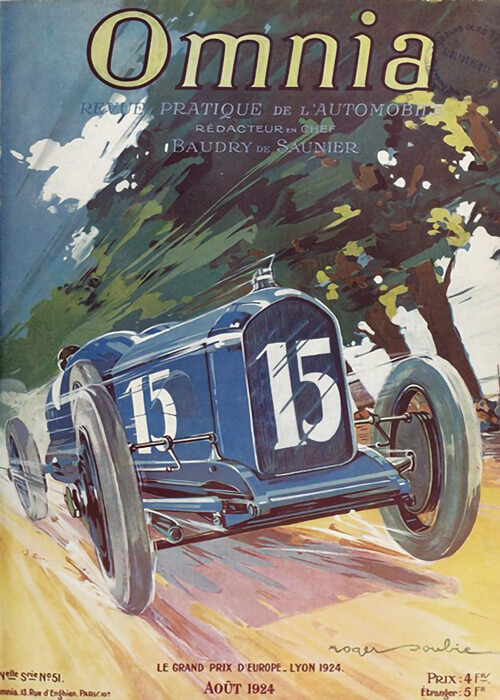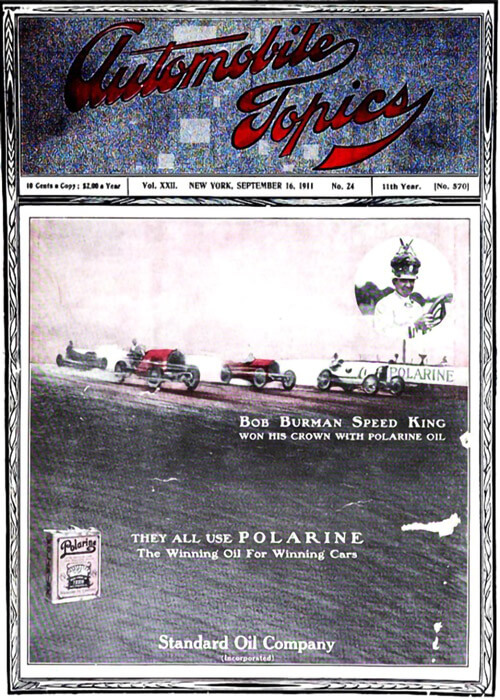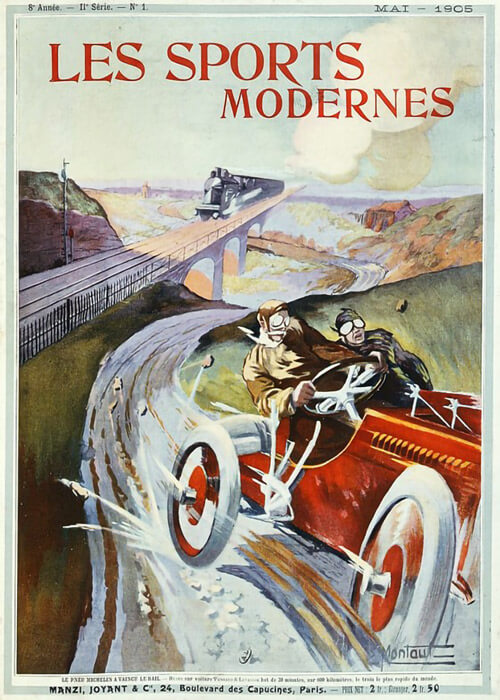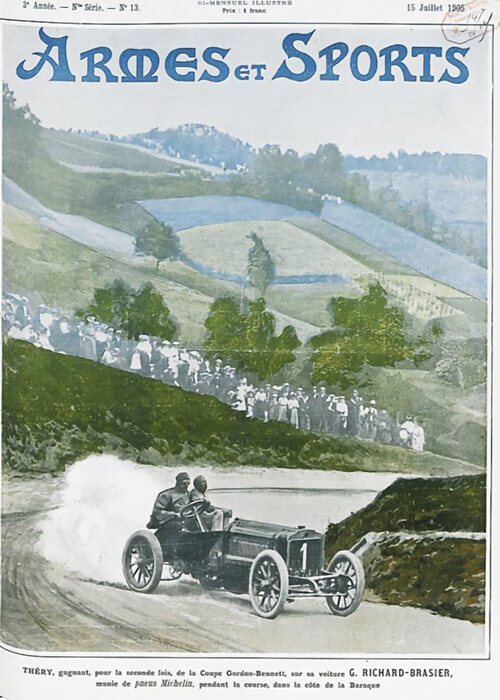The Horseless Age reported on the 1913 Indianapolis 500 mile race with a rather lenghty article. Therefore, it is here shown in two separate parts; „France wins the 500-mile Indianapolis Sweepatakes“ as first part, followed by the second part of their report „The Race from the Pits“. It is explained why the distance between the winner Goux and the 2nd placed Wishart was that large: first of all the heat on that day did reduce high speeds in general and secondly, during a relatively large part of the race, Goux could nurse his car at a moderate speed as he wasn’t threatened by his direct competitors.
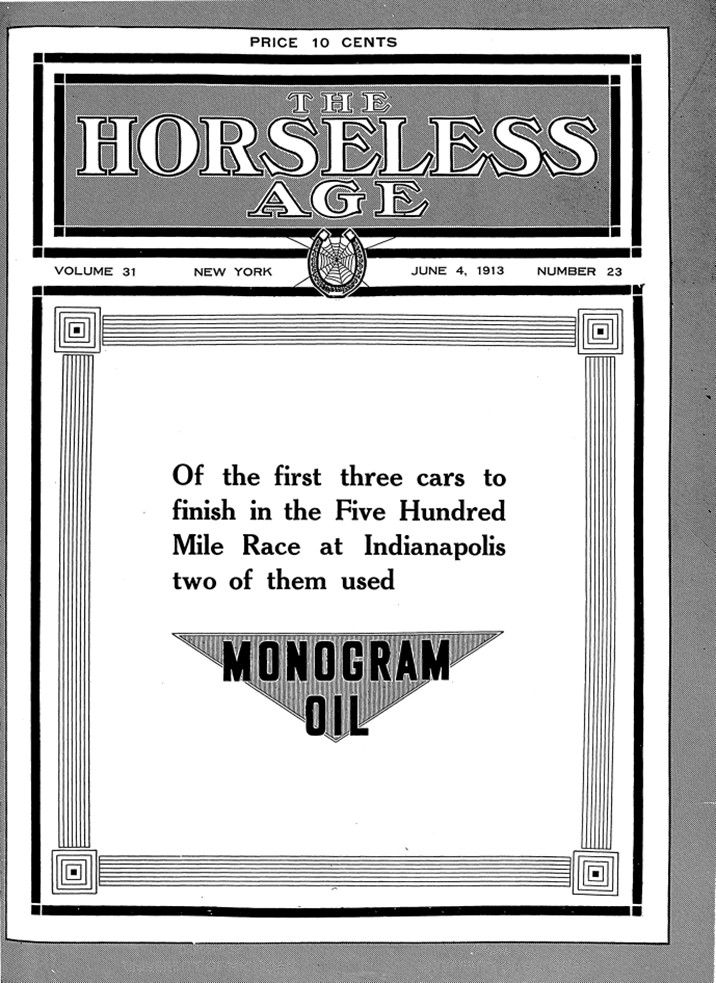
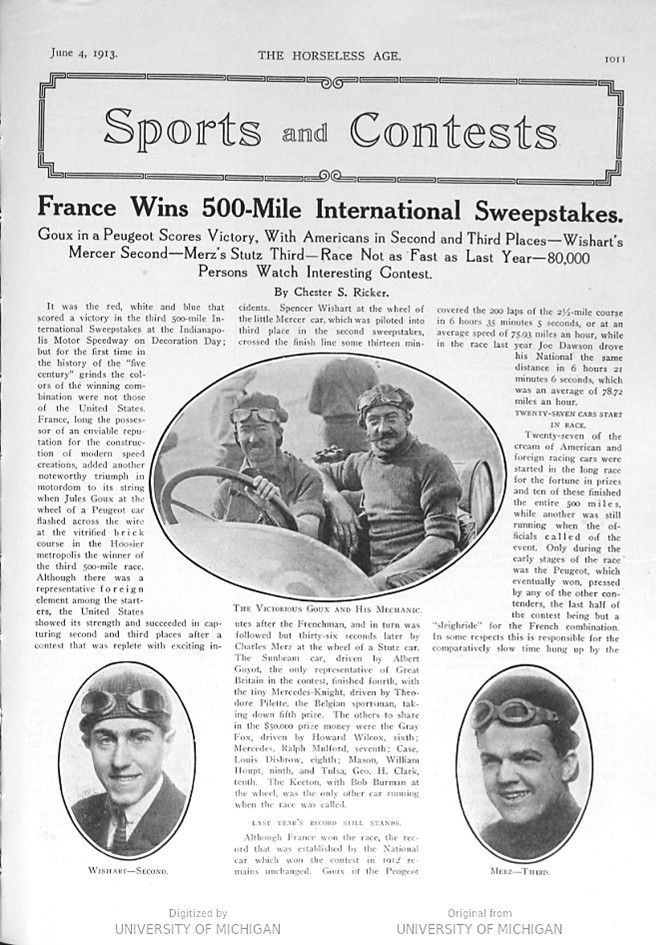
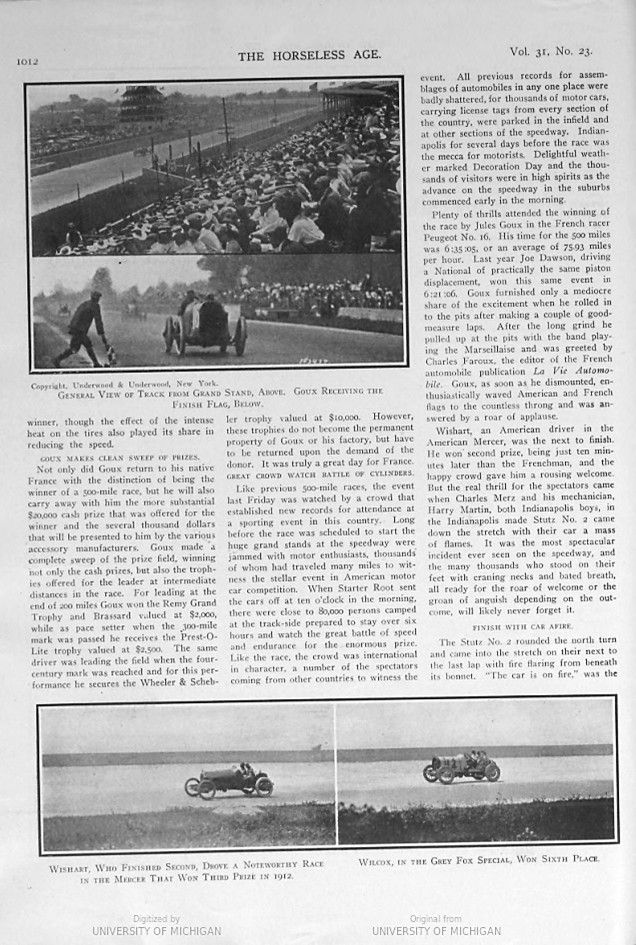
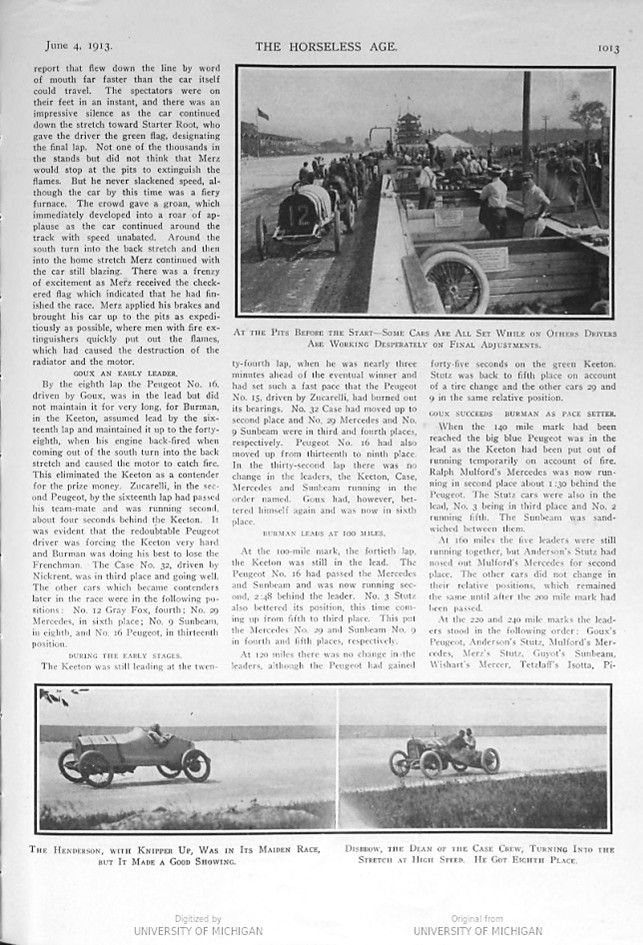
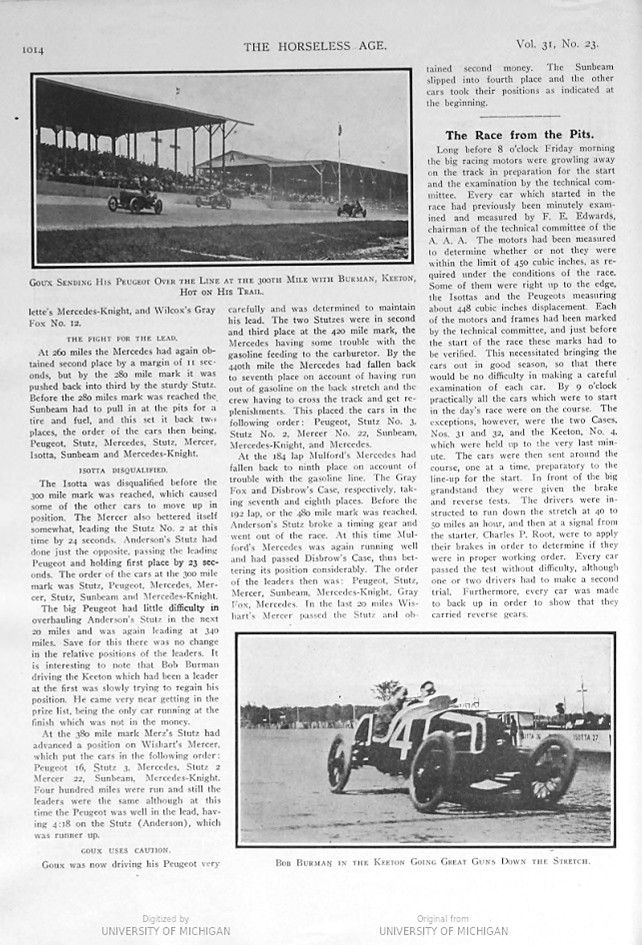
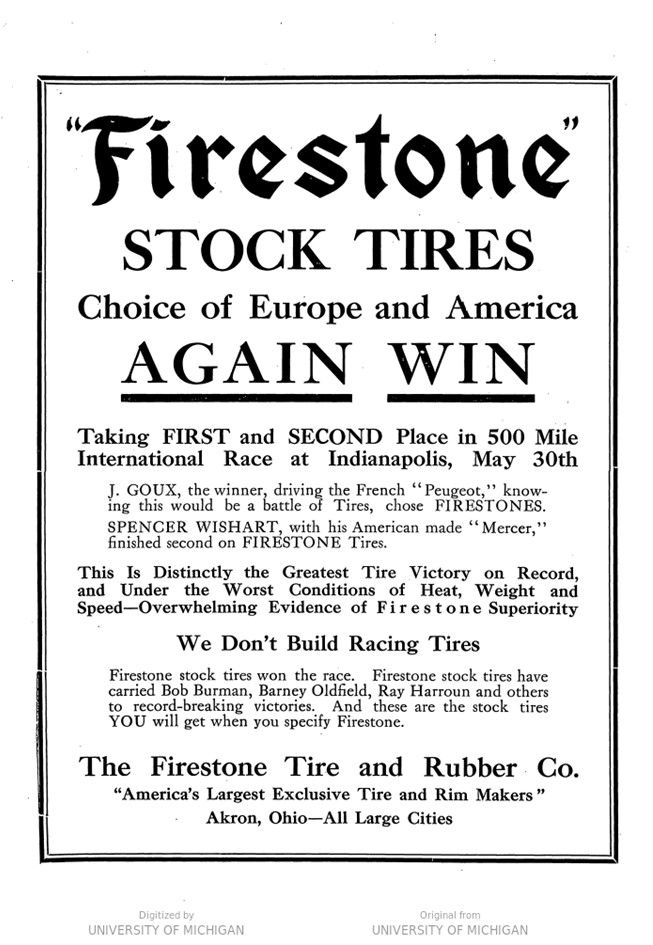
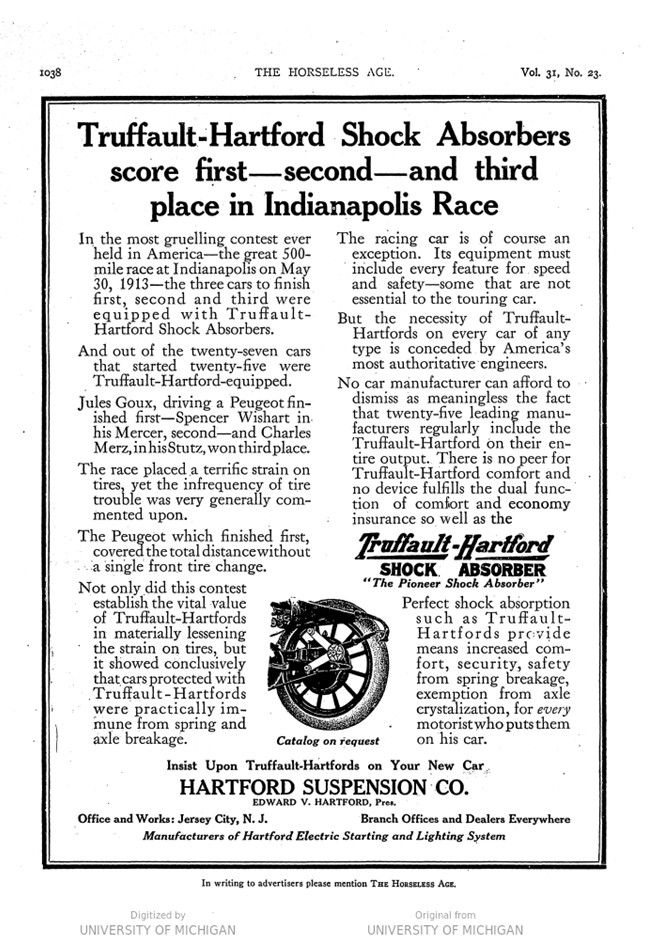
Text and jpegs by courtesy of hathitrust.org www.hathitrust.org, compiled by motorracinghistory.com
THE HORSELESS AGE – Vol. XXXI, No. 23, June 4, 1913
Sports and Contests
France Wins 500-Mile International Sweepstakes.
Goux in a Peugeot Scores Victory, With Americans in Second and Third Places —
Wishart’s Mercer Second — Merz’s Stutz Third – Race Not as Fast as Last Year —
80,000 Persons Watch Interesting Contest.
By Chester S. Ricker.
It was the red, white and blue that scored a victory in the third 500-mile International Sweepstakes at the Indianapolis Motor Speedway on Decoration Day; but for the first time in the history of the “five century” grinds the colors of the winning combination were not those of the United States. France, long the possessor of an enviable reputation for the construction of modern speed creations, added another noteworthy triumph in motordom to its string when Jules Goux at the wheel of a Peugeot car flashed across the wire at the vitrified brick course in the Hoosier metropolis the winner of the third 500-mile race. Although there was a representative foreign element among the starters, the United States showed its strength and succeeded in capturing second and third places after a contest that was replete with exciting incidents. Spencer Wishart at the wheel of the little Mercer car, which was piloted into third place in the second sweepstakes, crossed the finish line some thirteen minutes after the Frenchman, and in turn was followed but thirty-six seconds later by Charles Merz at the wheel of a Stutz car. The Sunbeam car, driven by Albert Guyot, the only representative of Great Britain in the contest, finished fourth, with the tiny Mercedes-Knight, driven by Theodore Pilette, the Belgian sportsman, taking down fifth prize. The others to share in the $50,000 prize money were the Gray Fox, driven by Howard Wilcox, sixth; Mercedes, Ralph Mulford, seventh; Case, Louis Disbrow, eighth; Mason, William Houpt, ninth, and Tulsa, Geo. H. Clark, tenth. The Keeton, with Bob Burman at the wheel, was the only other car running when the race was called.
LAST YEAR’S RECORD STILL STANDS.
Although France won the race, the record that was established by the National car which won the contest in 1912 remains unchanged. Goux in the Peugeot covered the 200 laps of the 2½-mile course in 6 hours 35 minutes 5 seconds, or at an average speed of 75.93 miles an hour, while in the race last year Joe Dawson drove his National the same distance in 6 hours 21 minutes 6 seconds, which was an average of 78.72 miles an hour.
TWENTY-SEVEN CARS START IN RACE.
Twenty-seven of the cream of American and foreign racing cars were started in the long race for the fortune in prizes and ten of these finished the entire 500 miles, while another was still running when the officials called of the event. Only during the early stages of the race was the Peugeot, which eventually won, pressed by any of the other contenders, the last half of the contest being but a „sleighride” for the French combination. In some respects, this is responsible for the comparatively slow time hung up by the winner, though the effect of the intense heat on the tires also played its share in reducing the speed.
GOUX MAKES CLEAN SWEEP OF PRIZES.
Not only did Goux return to his native France with the distinction of being the winner of a 500-mile race, but he will also carry away with him the more substantial $20,000 cash prize that was offered for the winner and the several thousand dollars that will be presented to him by the various accessory manufacturers. Goux made a complete sweep of the prize field, winning not only the cash prizes, but also the trophies offered for the leader at intermediate distances in the race. For leading at the end of 200 miles Goux won the Remy Grand Trophy and Brassard valued at $2,000, while as pace setter when the 300-mile mark was passed he receives the Prest-O-Lite trophy valued at $2,500. The same driver was leading the field when the four-century mark was reached and for this performance he secures the Wheeler & Schebler trophy valued at $10,000. However, these trophies do not become the permanent property of Goux or his factory but have to be returned upon the demand of the donor. It was truly a great day for France.
GREAT CROWD WATCH BATTLE OF CYLINDERS.
Like previous 500-mile races, the event last Friday was watched by a crowd that established new records for attendance at a sporting event in this country. Long before the race was scheduled to start the huge grand stands at the speedway were jammed with motor enthusiasts, thousands of whom had traveled many miles to witness the stellar event in American motor car competition. When Starter Root sent the cars off at ten o’clock in the morning, there were close to 80,000 persons camped at the trackside prepared to stay over six hours and watch the great battle of speed and endurance for the enormous prize. Like the race, the crowd was international in character, a number of the spectators coming from other countries to witness the event. All previous records for assemblages of automobiles in any one place were badly shattered, for thousands of motor cars, carrying license tags from every section of the country, were parked in the infield and at other sections of the speedway. Indianapolis for several days before the race was the mecca for motorists. Delightful weather marked Decoration Day, and the thousands of visitors were in high spirits as the advance on the speedway in the suburbs commenced early in the morning.
Plenty of thrills attended the winning of the race by Jules Goux in the French racer Peugeot No. 16. His time for the 500 miles was 6:35:05, or an average of 75.93 miles per hour. Last year Joe Dawson, driving a National of practically the same piston displacement, won this same event in 6:21:06. Goux furnished only a mediocre share of the excitement when he rolled in to the pits after making a couple of good-measure laps. After the long grind he pulled up at the pits with the band playing the Marseillaise and was greeted by Charles Faroux, the editor of the French automobile publication La Vie Automobile. Goux, as soon as he dismounted, enthusiastically waved American and French flags to the countless throng and was answered by a roar of applause.
Wishart, an American driver in the American Mercer, was the next to finish. He won second prize, being just ten minutes later than the Frenchman, and the happy crowd gave him a rousing welcome. But the real thrill for the spectators came when Charles Merz and his mechanician, Harry Martin, both Indianapolis boys, in the Indianapolis made Stutz No. 2, came down the stretch with their car a mass of flames. It was the most spectacular incident ever seen on the speedway, and the many thousands who stood on their feet with craning necks and bated breath, all ready for the roar of welcome or the groan of anguish depending on the outcome, will likely never forget it.
FINISH WITH CAR AFIRE.
The Stutz No. 2 rounded the north turn and came into the stretch on their next to the last lap with fire flaring from beneath its bonnet. „The car is on fire,“ was the report that flew down the line by word of mouth far faster than the car itself could travel. The spectators were on their feet in an instant, and there was an impressive silence as the car continued down the stretch toward Starter Root, who gave the driver the green flag, designating the final lap. Not one of the thousands in the stands but did not think that Merz would stop at the pits to extinguish the flames. But he never slackened speed, although the car by this time was a fiery furnace. The crowd gave a groan, which immediately developed into a roar of applause as the car continued around the track with speed unabated. Around the south turn into the back stretch and then into the home stretch Merz continued with the car still blazing. There was a frenzy of excitement as Merz received the checkered flag which indicated that he had finished the race. Merz applied his brakes and brought his car up to the pits as expeditiously as possible, where men with fire extinguishers quickly put out the flames, which had caused the destruction of the radiator and the motor.
GOUX AN EARLY LEADER.
By the eighth lap the Peugeot No. 16, driven by Goux, was in the lead but did not maintain it for very long, for Burman, in the Keeton, assumed lead by the sixteenth lap and maintained it up to the forty- eighth, when his engine back-fired when coming out of the south turn into the back stretch and caused the motor to catch fire. This eliminated the Keeton as a contender for the prize money. Zucarelli, in the second Peugeot, by the sixteenth lap had passed his team-mate and was running second, about four seconds behind the Keeton. It was evident that the redoubtable Peugeot driver was forcing the Keeton very hard and Burman was doing his best to lose the Frenchman. The Case No. 32, driven by Nickrent, was in third place and going well. The other cars which became contenders later in the race were in the following positions: No. 12 Gray Fox, fourth; No. 29 Mercedes, in sixth place; No. 9 Sunbeam, in eighth, and No. 16 Peugeot, in thirteenth position.
DURING THE EARLY STAGES.
The Keeton was still leading at the twenty-fourth lap, when he was nearly three minutes ahead of the eventual winner and had set such a fast pace that the Peugeot No. 15, driven by Zucarelli, had burned out its bearings. No. 32 Case had moved up to second place and No. 29 Mercedes and No. 9 Sunbeam were in third and fourth places, respectively. Peugeot No. 16 had also moved up from thirteenth to ninth place. In the thirty-second lap there was no change in the leaders, the Keeton, Case, Mercedes and Sunbeam running in the order named. Goux had, however, bettered himself again and was now in sixth place.
BURMAN LEADS AT 100 MILES.
At the 100-mile mark, the fortieth lap, the Keeton was still in the lead. The Peugeot No. 16 had passed the Mercedes and Sunbeam and was now running second, 2:48 behind the leader. No. 3 Stutz also bettered its position, this time coming up from fifth to third place. This put the Mercedes No. 29 and Sunbeam No. 9 in fourth and fifth places, respectively.
At 120 miles there was no change in the leaders, although the Peugeot had gained forty-five seconds on the green Keeton. Stutz was back to fifth place on account of a tire change and the other cars 29 and 9 in the same relative position.
GOUX SUCCEEDS BURMAN AS PACE SETTER.
When the 140-mile mark had been reached the big blue Peugeot was in the lead as the Keeton had been put out of running temporarily on account of fire. Ralph Mulford’s Mercedes was now running in second place about 1:30 behind the Peugeot. The Stutz cars were also in the lead, No. 3 being in third place and No. 2 running fifth. The Sunbeam was sandwiched between them.
At 160 miles the five leaders were still running together, but Anderson’s Stutz had nosed out Mulford’s Mercedes for second place. The other cars did not change in their relative positions, which remained the same until after the 200-mile mark had been passed.
At the 220- and 240-mile marks the leaders stood in the following order: Goux’s Peugeot, Anderson’s Stutz, Mulford’s Mercedes, Merz’s Stutz, Guyot’s Sunbeam, Wishart’s Mercer, Tetzlaff’s Isotta, Pilette’s Mercedes-Knight, and Wilcox’s Gray Fox No. 12.
THE FIGHT FOR THE LEAD.
At 260 miles the Mercedes had again obtained second place by a margin of 11 seconds, but by the 280-mile mark it was pushed back into third by the sturdy Stutz. Before the 280 miles mark was reached the Sunbeam had to pull in at the pits for a tire and fuel, and this set it back two places, the order of the cars then being, Peugeot, Stutz, Mercedes, Stutz, Mercer, Isotta, Sunbeam and Mercedes-Knight.

ISOTTA DISQUALIFIED.
The Isotta was disqualified before the 300-mile mark was reached, which caused some of the other cars to move up in position. The Mercer also bettered itself somewhat, leading the Stutz No. 2 at this time by 24 seconds. Anderson’s Stutz had done just the opposite, passing the leading Peugeot and holding first place by 23 seconds. The order of the cars at the 300-mile mark was Stutz, Peugeot, Mercedes, Mercer, Stutz, Sunbeam and Mercedes-Knight.
The big Peugeot had little difficulty in overhauling Anderson’s Stutz in the next 20 miles and was again leading at 340 miles. Save for this there was no change in the relative positions of the leaders. It is interesting to note that Bob Burman driving the Keeton which had been a leader at the first was slowly trying to regain his position. He came very near getting in the prize list, being the only car running at the finish which was not in the money.
At the 380-mile mark Merz’s Stutz had advanced a position on Wishart’s Mercer, which put the cars in the following order: Peugeot 16, Stutz 3, Mercedes, Stutz 2 Mercer 22, Sunbeam, Mercedes-Knight. Four hundred miles were run and still the leaders were the same although at this time the Peugeot was well in the lead, having 4:18 on the Stutz (Anderson), which was runner up.
GOUX USES CAUTION.
Goux was now driving his Peugeot very carefully and was determined to maintain his lead. The two Stutzes were in second and third place at the 420-mile mark, the Mercedes having some trouble with the gasoline feeding to the carburetor. By the 440th mile the Mercedes had fallen back to seventh place on account of having run out of gasoline on the back stretch and the crew having to cross the track and get replenishments. This placed the cars in the following order: Peugeot, Stutz No. 3, Stutz No. 2, Mercer No. 22, Sunbeam, Mercedes-Knight, and Mercedes.
At the 184 lap Mulford’s Mercedes had fallen back to ninth place on account of trouble with the gasoline line. The Gray Fox and Disbrow’s Case, respectively, taking seventh and eighth places. Before the 192 lap, or the 480-mile mark was reached, Anderson’s Stutz broke a timing gear and went out of the race. At this time Mulford’s Mercedes was again running well and had passed Disbrow’s Case, thus bettering its position considerably. The order of the leaders then was: Peugeot, Stutz, Mercer, Sunbeam, Mercedes-Knight, Gray Fox, Mercedes. In the last 20 miles Wishart’s Mercer passed the Stutz and obtained second money. The Sunbeam slipped into fourth place and the other cars took their positions as indicated at the beginning.
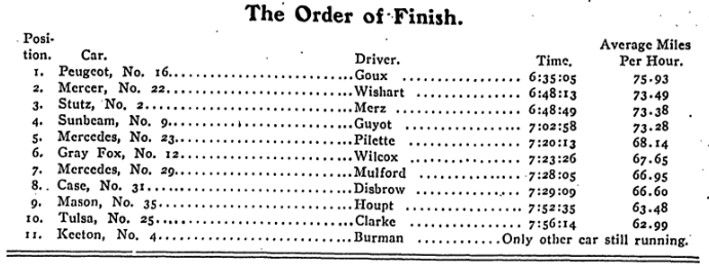
Photo captions.
Page 1011. The Victorious Goux and his mechanic. —– Wishart – Second. Merz – Third.
Page 1012.
Copyright, Underwood & Underwood, New York.
GENERAL VIEW OF TRACK FROM GRANDSTAND, ABOVE. GOUX RECEIVING THE FINISH FLAG, BELOW.
WISHART, WHO FINISHED SECOND, DROVE A NOTEWORTHY RACE IN THE MERCER THAT WON THIRD PRIZE IN 1912.
WILCOX, IN THE GREY FOX SPECIAL, WON SIXTH PLACE.
Page 1013.
AT THE PITS BEFORE THE START SOME CARS ARE ALL SET WHILE ON OTHERS, DRIVERS ARE WORKING DESPERATELY ON FINAL ADJUSTMENTS.
THE HENDERSON, WITH KNIPPER UP, WAS IN ITS MAIDEN RACE, BUT IT MADE A GOOD SHOWING.
DISBROW, THE DEAN OF THE CASE CREW, TURNING INTO THE STRETCH AT HIGH SPEED. HE GOT EIGHTH PLACE.
Page 1014.
GOUX SENDING HIS PEUGEOT OVER THE LINE AT THE 300TH MILE WITH BURMAN, KEETON, HOT ON HIS TRAIL.
BOB BURMAN IN THE KEETON GOING GREAT GUNS DOWN THE STRETCH.

